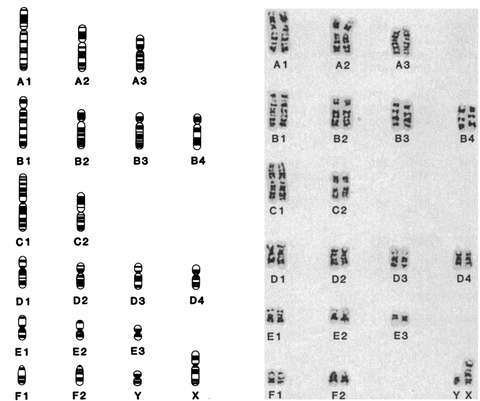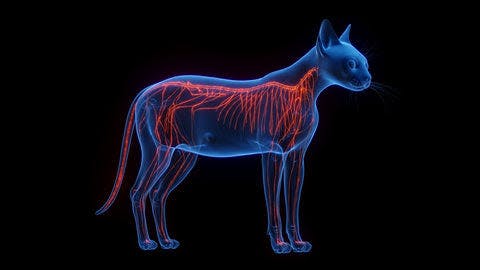Porphyrias is a term for a group of rare metabolic disorders that affect a cat’s ability to produce heme. Heme is an essential part of hemoglobin—a protein found in red blood cells that brings oxygen from a cat’s lungs to other parts of their body. Different types of porphyrias can occur in cats, as well as in humans and other animals. In this blog, we’ll discuss acute intermittent porphyria (AIP) in cats, its symptoms, and how it is diagnosed and treated by veterinarians.
What is Acute Intermittent Porphyria in Cats?
Acute intermittent porphyria (AIP) is a rare metabolic disease that affects a cat’s ability to make heme. But what is heme and why is it important?

Heme is an essential part of hemoglobin, a protein found in red blood cells that carries oxygen from a cat’s lungs to the rest of their body.
Heme is very important to the proper functioning of a cat’s liver.
Heme is made when enzymes interact with other substances in a cat’s bone marrow and liver. An enzyme is a biological catalyst that speeds up the rate of a chemical reaction. Enzymes are almost always proteins.
When it comes to making heme, natural chemicals called porphyrins must interact with an enzyme called hydroxymethylbilane synthase (HMBS).
During this interaction, the HMBS enzyme actually helps the porphyrins change into heme.
What Causes Acute Intermittent Porphyria in Cats?
Cats with acute intermittent porphyria don’t have enough HMBS enzymes to help the porphyrins change into heme. As a result, there’s a buildup of too many porphyrins in the cat’s body, and this leads to a range of health issues.

You may be wondering why cats with AIP don’t have enough HMBS enzymes. This happens when there are mutations in a specific gene that gives instructions to make the HMBS enzyme. For this reason, it is called the HMBS gene.
Remember that porphyrins must interact with the HMBS enzyme so that they can be changed into heme. However, mutations in the HMBS gene reduce the amount of the HMBS enzyme that is available for this transformation, and that is why too many porphyrins begin to accumulate.
Genetics of Acute Intermittent Porphyria
Cats have one pair of lettered sex chromosomes (X, Y) and 18 pairs of lettered (A-F) and numbered autosomal (non-sex) chromosomes. One chromosome in a pair comes from your cat’s mother, and one comes from their father. Chromosomes have names, and the HMBS gene connected with the potential for inherited acute intermittent porphyria (AIP) is located on a cat's chromosome D1. You can see this chromosome in the 1st column of the shaded side of Figure 1 below.

Figure 1. Graphical representations of each chromosome and trypsin Giemsa-banded staining of the chromosome pairs in domestic cats (Felis catus). Names of chromosomes follow the convention of Wurster-Hill and Gray (image taken from O’Brien and Nash, 1982).
Individual cats carry two different versions, known as “alleles”, of every gene that they inherit. The inheritance pattern of AIP can change depending on the allele that is inherited. As a result, AIP can be inherited as either an autosomal dominant disorder or as an autosomal recessive disorder. Let’s discuss what this all means:
“Autosomal” means that it’s associated with a gene that is located on one of the numbered and lettered non-sex chromosomes. In other words, it’s never the X or Y sex chromosomes shown (bottom far right areas of Figure 1).
“Dominant” disorder: a genetic disorder that occurs when a cat inherits a mutated HMBS gene from only one of their parents.
“Recessive” disorder: a genetic disorder occurs when a cat inherits mutated HMBS genes from both of their parents.
It is not recommended to breed any affected cats with AIP or cats that are carriers of AIP, since AIP can also be inherited as an autosomal recessive disorder.
Breeds at a Higher Risk for Acute Intermittent Porphyria
At this time, genetics research does not indicate that there are any specific cat breeds that are at a higher risk for developing acute intermittent porphyria (AIP) than other breeds.
How Does Acute Intermittent Porphyria Affect Cats?
Acute intermittent porphyria (AIP) is known as a type of hepatic porphyria. Hepatic means “of or relating to the liver”.

3D rendered medical illustration of cat anatomy - The liver.
The liver is the largest gland in a cat’s body, and among its many functions is the filtering and detoxifying of the blood. As porphyrins build up in the body of a cat with AIP, the liver is unable to properly function in this important filtering/detoxifying capacity. One of the bigger problems that occurs when a cat’s liver cannot function well is that this ultimately leads to secondary problems with a cat’s nervous system, which we’ll explore in the next section.
How are a Cat’s Liver and Nervous System Connected?
The liver and the nervous system of a cat, though quite different in function, are interrelated in several ways, as is true for most bodily systems. Let's first establish the basic functions of both systems:
Liver: The liver is a vital organ responsible for various metabolic functions, like filtering toxins from the blood, metabolizing drugs, producing bile to help in digestion, storing nutrients, and maintaining balanced blood sugar levels.
Nervous system: The nervous system is the body's control center. It's made up of the brain, the spinal cord, and nerves, and it regulates the body's responses to internal and external stimuli.

3D rendered medical illustration of cat anatomy - The Nervous system.
Now let's dive into how these two systems are connected:
Blood Circulation: The nervous system controls the heart rate, which in turn affects blood flow to the liver. This is essential because the liver requires a constant supply of oxygen and nutrients, carried by the blood, to function properly.
Chemical Messaging: Certain chemicals produced in the liver can have an effect on the nervous system. For example, if the liver is not working properly, it can lead to the build-up of toxins in the bloodstream that can affect the brain. This condition, known as hepatic encephalopathy, can lead to changes in behavior, confusion, or even coma in cats.
Autonomic Nervous System: This part of the nervous system controls involuntary functions, including some liver functions. For instance, the parasympathetic nervous system, a part of the autonomic nervous system, can stimulate bile production in the liver.
Endocrine System: Both the liver and the nervous system interact with the endocrine system, which is the body's hormone production system. The liver helps to metabolize certain hormones, which can then have an effect on the nervous system.
We can think of the liver and the nervous system as different players on the same team, working together to ensure that a cat's body functions properly. If the liver isn't doing its job well, the nervous system can be affected, and vice versa.
What Are The Symptoms of Acute Intermittent Porphyria in Cats?
Though it is possible for a cat to be asymptomatic (aka not show any clinical signs), typical symptoms of AIP include:
Lethargy/general weakness
Vomiting
Diarrhea
Abdominal pain
Dark yellow-brown urine
Reddish-brown teeth (also known as erythrodontia)
Increased thirst and urination
Some of these symptoms can also be associated with a range of other conditions. That’s why it’s always important to consult with your veterinarian about any concerns and/or changes in your cat’s health, so that they can examine your cat and recommend appropriate next steps to confirm a diagnosis.
Diagnosis of Acute Intermittent Porphyria in Cats
A veterinarian will conduct a thorough exam, including a review of a cat’s health history and any clinical signs. Diagnosis of AIP in cats is typically determined with blood and urine tests that measure levels of porphyrins, the chemical substances that accumulate in the body as a result of the disorder. Genetic testing for AIP can also help confirm a diagnosis.
Depending on the cat, a vet may make recommendations for additional laboratory tests to help determine if any other metabolic, endocrine, or infectious conditions could be affecting the cat’s nervous system.
Treatment of Acute Intermittent Porphyria in Cats
There is no cure for acute intermittent porphyria (AIP) in cats. Since severity and symptoms of AIP can vary, treatment typically involves managing symptoms and avoiding potential triggers that can worsen the condition. In some cases, a special diet or medications may be recommended to help manage the symptoms of the condition. It is important to work closely with a veterinarian to properly manage and treat AIP in an affected cat.

Conclusion
Acute intermittent porphyria (AIP) is a rare genetic disorder that affects a cat’s liver and nervous system. We hope that this blog on AIP has been helpful, and remember that the Basepaws Breed + Health Cat DNA Test screens for five different mutations in the HMBS gene that are associated with this rare disease. If you want to get to know your cat better—both inside and out—our Breed + Health Cat DNA Test provides a comprehensive overview of your cat's health predispositions. Know your cat’s risk for potentially developing AIP or any of the other 42 genetic diseases for which we screen, so that you can be proactive and support your cat’s well-being to help them live a better life, even longer!
